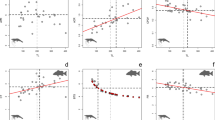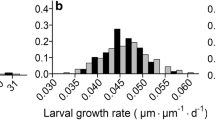Abstract
In gape-limited predators, gape size restricts the maximum prey size a predator is capable to ingest. However, studies investigating the energetic consequences of this relationship remain scarce. In this study, we tested the hypothesis that gape-size variability influences individual body condition (a common proxy for fitness) in one of the largest freshwater teleost predators, the barramundi. We found that individual barramundi with larger gapes relative to body size had higher body condition values compared to conspecifics with smaller gapes. Body condition was highest soon after the wet season, a period of high feeding activity on productive inundated floodplains, and body condition decreased as the dry season progressed when fish were restricted to dry season remnant habitats. The increased condition obtained during the wet season apparently offsets weight loss through the dry season, as individuals with large gapes were still in better condition than fish with small gapes in the late-dry season. Elucidation of the links between intraspecific variability in traits and performance is a critical challenge in functional ecology. This study emphasizes that even small intraspecific variability in morphological trait values can potentially affect individual fitness within a species’ distribution.



Similar content being viewed by others
References
Albouy C, Guilhaumon F, Villéger S, Mouchet M, Mercier L, Culioli J, Tomasini J, Le Loc’h F, Mouillot D (2011) Predicting trophic guild and diet overlap from functional traits: statistics, opportunities and limitations for marine ecology. Mar Ecol Prog Ser 436:17–28
Anderson JT, Saldaña-Rojas J, Flecker AS (2009) High-quality seed dispersal by fruit-eating fishes in Amazonian floodplain habitats. Oecologia 161:279–290
Arrington DA, Winemiller KO, Layman CA (2005) Community assembly at the patch scale in a species rich tropical river. Oecologia 144:157–167
Balcombe SR, Lobegeiger JS, Marshall SM, Marshall JC, Ly D, Jones DN (2012) Fish body condition and recruitment success reflect antecedent flows in an Australian dryland river. Fish Sci 78:841–847
Balcombe SR, Arthington AH, Sternberg D (2014) Fish body condition and recruitment responses to antecedent flows in dryland rivers are species and river specific. River Res Appl 30:1257–1268
Bates D, Maechler M, Bolker B, Walker S, Christensen RHB, Singmann H, Dai B, Scheipl F, Grothendieck G, Green P, Fox J (2018) Linear mixed-effects models using ‘Eigen’ and S4. R Package ‘lme4’.https://cran.r-project.org/web/packages/lme4/. Accessed 26 Nov 2018
Bishop KA, Allen SA, Pollard DA, Cook MG (2001) Ecological studies on the freshwater fishes of the Alligator rivers region, northern territory: autecology. supervising scientist report 145, Supervising scientist, Darwin
Blanck A, Lamouroux N (2007) Large scale intraspecific variation in life history traits of European freshwater fish. J Biogeogr 34:862–875
Bolger T, Connolly PL (1989) The selection of suitable indices for the measurement and analysis of fish condition. J Fish Biol 34:171–182
Cattau CE, Fletcher RJ Jr, Kimball RT, Miller CW, Kitchens WM (2018) Rapid morphological change of a top predator with the invasion of a novel prey. Nat Ecol Evol 2:108–115
Cooper WJ, Carter CB, Conith AJ, Rice AN, Westneat MW (2017) The evolution of jaw protrusion mechanics is tightly coupled to bentho-pelagic divergence in damselfishes (Pomacentridae). J Exp Biol 220:652–666
Crook DA, Buckle DJ, Allsop Q, Baldwin W, Saunders TM, Kyne PM, Woodhead JD, Maas R, Roberts B, Douglas MM (2017) Use of otolith chemistry and acoustic telemetry to elucidate migratory contingents in barramundi Lates calcarifer. Mar Freshw Res 68:1554–1566
Davis TLO (1985) The food of barramundi, Lates calcarifer (Bloch), in coastal and inland waters of Van Diemen Gulf and the Gulf of Carpentaria, Australia. J Fish Biol 26:669–682
Des Roches S, Post DM, Turley NE, Bailey JK, Hendry AP, Kinnison MT, Schweitzer JA, Palkovacs EP (2018) The ecological importance of intraspecific variation. Nat Ecol Evol 2:57–64
Detmer TM, Einfalt LM, Parkos JJ, Wahl DH (2018) Comparison of mouth morphology and prey size selection among three esocid taxa. Environ Biol Fish 101:1–10
Ebner BC, Morgan DL, Kerezsy A, Hardie S, Beatty SJ, Seymour JE, Donaldson JA, Linke S, Peverell S, Roberts D, Espinoza T (2016) Enhancing conservation of Australian freshwater ecosystems: identification of freshwater flagship fishes and relevant target audiences. Fish Fish 17:1134–1151
Ehlinger TJ, Wilson D (1988) Complex foraging polymorhphism in bluegill sunfish. Proc Natl Acad Sci 85:1878–1882
Forsman A (1996) Body size and net energy gain in gape-limited predators: a model. J Herpetol 30:307–319
Forsman A, Shine R (1997) Rejection of non-adaptive hypotheses for intraspecific variation in trophic morphology in gape-limited predators. Biol J Linn Soc 62:209–223
Gatz AJ (1979) Ecological morphology of freshwater stream fishes. Tulane Stud Zool Bot 21:91–124
Gerking SD (1994) Feeding ecology of fish. Academic Press, California
Hall ES, Martin BE, Brubaker K, Grant CJ (2018) Latitudinal variation in the geometric morphology of the largemouth bass, Micropterus salmoides. Mar Freshw Res 69:1480–1485
Hambright KD (1991) Experimental analysis of prey selection by largemouth bass: role of predator mouth width and prey body depth. Trans Am Fish Soc 120:500–508
Hobson ES (1979) Interactions between piscivorous fishes and their prey. In: Clepper H, Stroud RH (eds) Predator–Prey systems in fisheries management. Sport Fishing Institute, DC, pp 231–242
Hoeinghaus DJ, Winemiller KO, Layman CA, Arrington DA, Jepsen DB (2006) Effects of seasonality and migratory prey on body condition of Cichla species in a tropical floodplain river. Ecol Freshw Fish 15:398–407
Jakob EM, Marshall SD, Uetz GW (1996) Estimating fitness: a comparison of body condition indices. Oikos 77:61–67
Jardine TD, Pettit NE, Warfe DM, Pusey BJ, Ward DP, Douglas MM, Davies PM, Bunn SE (2012) Consumer–resource coupling in wet–dry tropical rivers. J Anim Ecol 81:310–322
Juanes F (1994) What determines prey size selectivity in piscivorous fishes? In: Stouder DJ, Fresh KL, Feller R (eds) Theory and application in fish feeding ecology. University of South Carolina Press, South Carolina, pp 77–100
Juanes F, Buckel JA, Scharf FS (2002) Feeding ecology of piscivorous fishes. In: Hart P, Reynolds JD (eds) Handbook of fish biology and fisheries: fish biology, 1st edn. Blackwell Scientific, Oxford, pp 267–283
Karpouzi VS, Stergiou KI (2003) The relationships between mouth size and shape and body length for 18 species of marine fishes and their trophic implications. J Fish Biol 62:1353–1365
Kennard MJ, Pusey BJ, Olden JD, Mackay SJ, Stein JL, Marsh N (2010) Classification of natural flow regimes in Australia to support environmental flow management. Freshw Biol 55:171–193
Kristjánsson B, Skúlason S, Noakes DLG (2002) Rapid divergence in a recently isolated population of threespine stickleback (Gasterosteus aculeatus L.). Evol Ecol Res 4:659–672
Kuznetsova A, Brockhoff PB, Christensen RHB (2018) Tests in linear mixed effects models. R package ‘lmerTest’. https://cran.r-project.org/web/packages/lmerTest/. Accessed 26 Nov 2018
Magnhagen C, Heino E (2001) Gape size allometry in pike reflects variation between lakes in prey availability and relative body depth. Funct Ecol 15:754–762
Maret TJ, Collins JP (1996) Effect of prey vulnerability on population size structure of a gape-limited predator. Ecology 77:320–324
McGill BJ, Enquist BJ, Weiher E, Westoby M (2006) Rebuilding community ecology from functional traits. Trends Ecol Evol 21:178–185
Messier J, McGill BJ, Lechowicz MJ (2010) How do traits vary across ecological scales? A case for trait-based ecology. Ecol Lett 13:838–848
Miehls AL, Peacor SD, McAdam AG (2014) Gape-limited predators as agents of selection on the defensive morphology of an invasive invertebrate. Evolution 68:2633–2643
Mihalitsis M, Bellwood DR (2017) A morphological and functional basis for maximum prey size in piscivorous fishes. PLoS One 12:e0184679
Nilsson PA, Brönmark C (2000) Prey vulnerability to a gape-size limited predator: behavioural and morphological impacts on northern pike piscivory. Oikos 88:39–546
Norin T, Clark TD (2017) Fish face a trade-off between ‘eating big’ for growth efficiency and ‘eating small’ to retain aerobic capacity. Biol Lett 13:20170298
Norton SF (1995) A functional approach to ecomorphological patterns of feeding in cottid fishes. Environ Biol Fish 44:61–78
Peig J, Green AJ (2009) New perspectives for estimating body condition from mass/length data: the scaled mass index as an alternative method. Oikos 118:1883–1891
Persson L, Andersson J, Wahlstrom E, Eklov P (1996) Size-specific interactions in lake systems: predator gape limitation and prey growth rate and mortality. Ecology 77:900–911
Pettit NE, Naiman RJ, Warfe DM, Jardine TD, Douglas MM, Bunn SE, Davies PM (2017) Productivity and connectivity in tropical riverscapes of northern Australia: ecological insights for management. Ecosystems 20:492–514
Phillips B, Shine R (2004) Adapting to an invasive species: toxic cane toads induce morphological change in Australian snakes. Proc Natl Acad Sci 101:17150–17155
Pope KL, Kruse CG (2007) Condition. In: Guy CS, Brown ML (eds) Analysis and interpretation of freshwater fisheries data. American Fisheries Society, Maryland, pp 423–471
Pusey B, Kennard M, Arthington A (2004) Freshwater fishes of north–eastern Australia. CSIRO publishing, Australia
R Development Core Team (2019) R: a language and environment for statistical computing. See http://www.r-project.org. Accessed 26 Nov 2018
Saunders T, Whybird O, Newman S (2018) Status of key northern territory fish stocks report 2016. Northern territory government. Department of primary industry and resources. http://www.fish.gov.au/report/7-Barramundi-2016. Accessed 30 Nov 2018
Scharf FS, Juanes F, Rountree RA (2000) Predator size–prey size relationships of marine fish predators: interspecific variation and effects of ontogeny and body size on trophic niche breadth. Mar Ecol Prog Ser 208:229–248
Schmitt RJ, Holbrook SJ (1984) Gape-limitation, foraging tactics and prey size selectivity of two microcarnivorous species of fish. Oecologia 63:6–12
Sutton SG, Bult TP, Haedrich RL (2000) Relationships among fat weight, body weight, water weight, and condition factors in wild Atlantic salmon parr. Trans Am Fish Soc 129:527–538
Urban MC (2007) The growth–predation risk trade-off under a growing gape-limited predation threat. Ecology 88:2587–2597
Vatland S, Budy P (2007) Predicting the invasion success of an introduced omnivore in a large, heterogeneous reservoir. Can J Fish Aquat Sci 64:1329–1345
Villéger S, Brosse S, Mouchet M, Mouillot D, Vanni MJ (2017) Functional ecology of fish: current approaches and future challenges. Aquat Sci 79:783–801
Violle C, Navas ML, Vile D, Kazakou E, Fortunel C, Hummel I, Garnier E (2007) Let the concept of trait be functional! Oikos 116:882–892
Violle C, Enquist BJ, McGill BJ, Jiang LIN, Albert CH, Hulshof C, Jung V, Messier J (2012) The return of the variance: intraspecific variability in community ecology. Trends Ecol Evol 27:244–252
Voshikawa T, Higuchi H (2018) Invasion of the loquat Eriobotrya japonica into urban areas of central Tokyo facilitated by crows. Ornithol Sci 17:165–172
Warfe DM, Pettit NE, Davies PM, Pusey BJ, Hamilton SK, Kennard MJ, Towsend SA, Bayliss P, Ward DP, Douglas MM, Burford MA, Finn M, Bunn SE, Halliday IA (2011) The ‘wet–dry’ in the wet–dry tropics drives river ecosystem structure and processes in northern Australia. Freshw Biol 56:2169–2195
Winemiller KO, Jepsen DB (1998) Effects of seasonality and fish movement on tropical river food webs. J Fish Biol 53:267–296
Xiao Y (2000) Use of the original von Bertalanffy growth model to describe the growth of barramundi, Lates calcarifer (Bloch). Fish Bull 98:835
Acknowledgements
We thank B. Adair, K. Keller, D. Lowensteiner, Q. Allsop, W. Baldwin, C. Errity, N. Croft for assistance with field sampling, R. Morais and three anonymous reviews for comments that improved the manuscript, and B. Adair and D. Lowensteiner for assistance with fish measurement in the laboratory.
Funding
Financial support was provided by the Australian Research Council (LP150100388) and the Department of Primary Industry and Fisheries, Northern Territory Government.
Author information
Authors and Affiliations
Contributions
AJK, DAC, JDO, MJK, MMD and TMS conceived the study. AJK, DW and OJL collected the data. OJL analyzed the data and wrote the first draft of the manuscript and all authors contributed to revisions.
Corresponding author
Additional information
Communicated by Joel Trexler.
Electronic supplementary material
Below is the link to the electronic supplementary material.
Rights and permissions
About this article
Cite this article
Luiz, O.J., Crook, D.A., Kennard, M.J. et al. Does a bigger mouth make you fatter? Linking intraspecific gape variability to body condition of a tropical predatory fish. Oecologia 191, 579–585 (2019). https://doi.org/10.1007/s00442-019-04522-w
Received:
Accepted:
Published:
Issue Date:
DOI: https://doi.org/10.1007/s00442-019-04522-w




